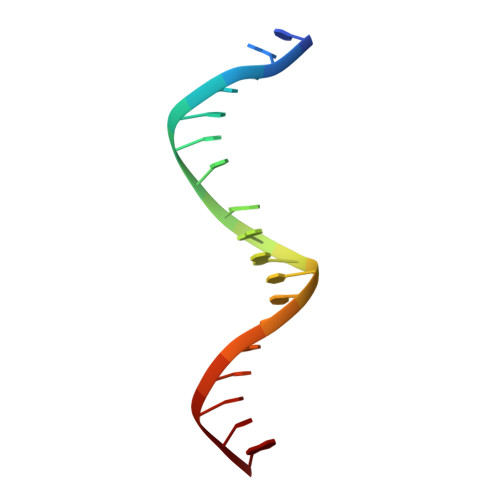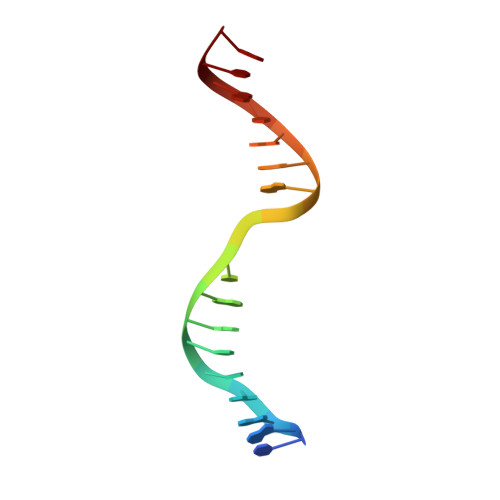Structure of a Stable Interstrand DNA Cross-Link Involving a beta- N -Glycosyl Linkage Between an N 6 -dA Amino Group and an Abasic Site.
Kellum Jr., A.H., Qiu, D.Y., Voehler, M.W., Martin, W., Gates, K.S., Stone, M.P.(2021) Biochemistry 60: 41-52
- PubMed: 33382597
- DOI: https://doi.org/10.1021/acs.biochem.0c00596
- Primary Citation of Related Structures:
6XAH - PubMed Abstract:
Abasic (AP) sites are one of the most common forms of DNA damage. The deoxyribose ring of AP sites undergoes anomerization between α and β configurations, via an electrophilic aldehyde intermediate. In sequences where an adenine residue is located on the opposing strand and offset 1 nt to the 3' side of the AP site, the nucleophilic N 6 -dA amino group can react with the AP aldehyde residue to form an interstrand cross-link (ICL). Here, we present an experimentally determined structure of the dA-AP ICL by NMR spectroscopy. The ICL was constructed in the oligodeoxynucleotide 5'-d(T 1 A 2 T 3 G 4 T 5 C 6 T 7 A 8 A 9 G 10 T 11 T 12 C 13 A 14 T 15 C 16 T 17 A 18 )-3':5'-d(T 19 A 20 G 21 A 22 T 23 G 24 A 25 A 26 C 27 X 28 T 29 A 30 G 31 A 32 C 33 A 34 T 35 A 36 )-3' (X=AP site), with the dA-AP ICL forming between A 8 and X 28 . The NMR spectra indicated an ordered structure for the cross-linked DNA duplex and afforded detailed spectroscopic resonance assignments. Structural refinement, using molecular dynamics calculations restrained by NOE data (rMD), revealed the structure of the ICL. In the dA-AP ICL, the 2'-deoxyribosyl ring of the AP site was ring-closed and in the β configuration. Juxtapositioning the N 6 -dA amino group and the aldehydic C1 of the AP site within bonding distance while simultaneously maintaining two flanking unpaired A 9 and T 29 bases stacked within the DNA is accomplished by the unwinding of the DNA at the ICL. The structural data is discussed in the context of recent studies describing the replication-dependent unhooking of the dA-AP ICL by the base excision repair glycosylase NEIL3.
Organizational Affiliation:
Department of Chemistry, Vanderbilt University Center for Structural Biology, and the Vanderbilt-Ingram Cancer Center, Vanderbilt University, Nashville, Tennessee 37235, United States.















